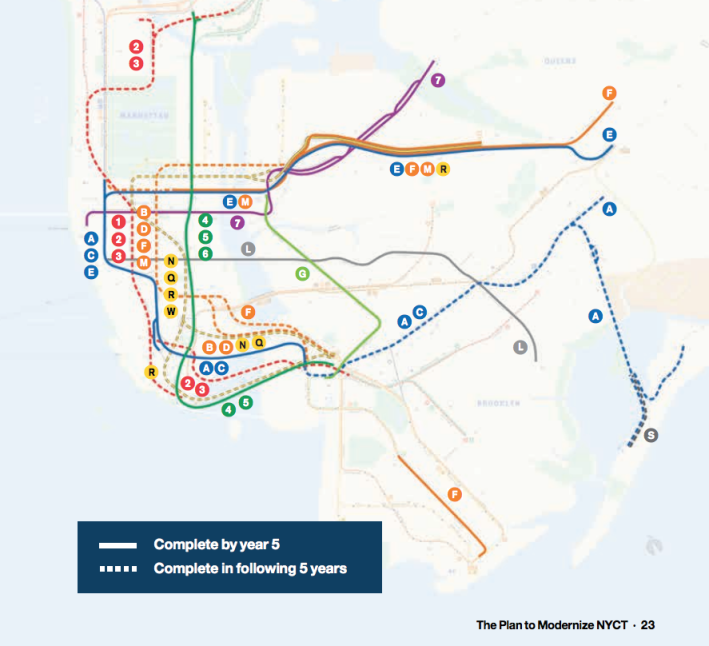Congestion pricing litigation may knock the MTA's ambitious signal modernization plans off track, transit officials said — as the agency determines what fixes to pursue in its next five-year capital plan.
Signal upgrades on a chunk of the B, D, F and M lines between 21st St-Queensbridge in Queens and Jay Street in Brooklyn hang in the balance of the pending lawsuits because the MTA planned for congestion pricing to help pay for them, an agency spokesperson said.
"This future procurement requires resolution of congestion pricing litigation in order to be advanced," said the representative, Joana Flores.
Congestion pricing tolls on vehicles entering Manhattan below 60th Street are slated to fund $15 billion of the MTA's $55-billion capital plan — but lawsuits filed by the state of New Jersey and other opponents have thrown a spanner in the MTA's funding works.
The uncertainty has already waylaid plans to award a contract to upgrade signals and a pair of junctions on the A and C lines in Brooklyn.
Officials pushed the projects from late 2023 to sometime in 2024 because those upgrades were also predicated on revenue from congestion pricing, the New York Post previously reported.
The growing uncertainty around the funding for the signal upgrades, known as Communications Based Train Control, poses a major test of the MTA's effort to make timely upgrades to its aging signal system in places where the century-old infrastructure guides trains — once upheld by MTA leaders as the key to improving subway service.
Former New York City Transit President Andy Byford proposed a 10-year plan in 2019 to upgrade signals on 18 subway lines across the system, bringing modern signaling to over 60 percent of the system's track miles, as part of his Fast Forward proposal to revive the ailing transit system.
Byford's program focused on decreasing headways and increasing reliability by replacing old "fixed block" signals, which communicate to train operators if they can safely advance their train, with computerized "moving block" signals that provide more accurate information about the locations of trains on the track.
Fast Forward was merely a blueprint, but officials turned its goals into specific commitments in the 2020-2024 capital plan. Officials pledged to use funding from the state, feds and congestion tolls to upgrade signals on several lines encompassing a huge chunk of the subway network:
- Queens Boulevard Line East (The E and F trains from Kew Gardens - Union Turnpike to Jamaica 179 St and Jamaica Center - Parsons / Archer)
- The Crosstown line (The G train from Court Square to Hoyt - Schermerhorn)
- The Fulton line (The A and C trains from Jay St to Euclid Av)
- The Astoria line (The N and W trains from Astoria Ditmars Blvd to 57 St-7 Av)
- The 63rd Street corridor (The F train from 21-Queensbridge to 57th St-6 Av)
- The Lexington Avenue line (The 4, 5 and 6 trains 149th St-Grand Concourse to Nevins St)
Those projects joined previous ongoing planning and capital work elsewhere in the system awarded in past capital plans and included in Fast Forward — including a segment of the F train in Brooklyn, the Queens Boulevard line between Kew Gardens, Queens, and 50th Street in Manhattan, and the A, C and E trains between 59th Street and High Street.

But the MTA made changes to the capital plan in June 2022. Officials moved the Lexington Avenue and Astoria lines out of the current plan to instead focus on segments of the lines with the worst reliability in the system.
The modified plans kept the spirit of Fast Forward alive — since officials expanded the Fulton line work to include upgrades to the Hoyt Street and Jay Street junctions in Brooklyn, and stretched the existing plan for work on the 63rd Street corridor to encompass the B, D and M on the Sixth Avenue line in Manhattan and the F train all the way to Jay Street in Brooklyn. Those projects are now in limbo due to the uncertainty around congestion pricing funding.
The MTA's inability to move forward on the two contracts comes as the agency enters the final year of the 2020-2024 capital plan and officials begin to plan for the 2025-2029 plan.
The new five-year plan appears to have a different set of blueprints than Byford's Fast Forward, at least according to the agency's 20-Year Needs Assessment released in October.
The MTA included a look at the state of the signal system in the "Needs Assessment" study of the system's physical inventory, but said its commitment to getting modern subway signals on 80 percent of the system now runs through 2044.
Transit observers have noticed a slight shift in how MTA leadership talks about signals.
"As part of the capital work emphasis I’ve seen shift, accessibility seems to have a higher priority, as do state-of-good-repair overall, and resiliency," said Lisa Daglian, executive director of the Permanent Citizens Advisory Committee to the MTA.
"CBTC is and must be part of the work that looks to the reliability of the system going forward, but the 20-Year Needs Assessment shined a different light on how they prioritize work and may have changed the broader thematic approach."
In contrast to the dramatic emphasis on signal upgrades on the current capital plan, CBTC signal upgrades are simply "one of the themes" for the 2025-2029 effort, MTA CEO Janno Lieber said on Wednesday.
"It's going to be one of the themes, because it's such a proven success story for New York," Lieber told Streetsblog. "Look at the change that was made on the 7. Weeks after we turned CBTC on-time performance went from 68 percent to something in the high 80s and low 90s."






